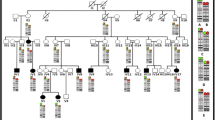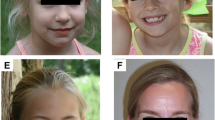Abstract
The basic genomic defect in Wolf–Hirschhorn syndrome (WHS), including isolated 4p deletions and various unbalanced de novo 4p;autosomal translocations and above all t(4p;8p), is heterogeneous. Olfactory receptor gene clusters (ORs) on 4p were demonstrated to mediate a group of WHS-associated t(4p;8p)dn translocations. The breakpoint of a 4-Mb isolated deletion was also recently reported to fall within the most distal OR. However, it is still unknown whether ORs mediate all 4p-autosomal translocations, or whether they are involved in the origin of isolated 4p deletions. Another unanswered question is whether a parental inversion polymorphism on 4p16 can act as predisposing factor in the origin of WHS-associated rearrangements. We investigated the involvement of the ORs in the origin of 73 WHS-associated rearrangements. No hotspots for rearrangements were detected. Breakpoints on 4p occurred within the proximal or the distal olfactory receptor gene cluster in 8 of 73 rearrangements (11%). These were five t(4p;8p) translocations, one t(4p;7p) translocation and two isolated terminal deletions. ORs were not involved in one additional t(4p;8p) translocation, in a total of nine different 4p;autosomal translocations and in the majority of isolated deletions. The presence of a parental inversion polymorphism on 4p was investigated in 30 families in which the 4p rearrangements, all de novo, were tested for parental origin (7 were maternal and 23 paternal). It was detected only in the mothers of 3 t(4p;8p) cases. We conclude that WHS-associated chromosome changes are not usually mediated by low copy repeats. The 4p16.3 inversion polymorphism is not a risk factor for their origin.

Similar content being viewed by others
References
Dallapiccola B, Mandich P, Bellone E, Selicorni A, Mokin V, Ajmar F, Novelli G (1993) Parental origin of chromosome 4p deletion in Wolf–Hirschhorn sindrome. Am J Med Genet 47:921–924
Faravelli F, Murdolo M, Marangi G, Bricarelli FD, Di Rocco M, Zollino M (2007) Mother to son amplification of small subtelomeric deletion: a new mechanism of familial recurrence in microdeletion syndrome. Am J Med Genet 136A:1169–1173
Giglio S, Broman KW, Matsumoto N, Calvari V, Gimelli G, Neumann T, Ohashi H, Voullaire L, Larizza D, Giorda R, Weber JL, Ledbetter DH, Zuffardi O (2001) Olfactory receptor-gene clusters, genomic-inversion polymorphisms, and common chromosome rearrangments. Am J Hum Genet 68:874–883
Giglio S, Calvari V, Gregato G, Gimelli G, Camanini S, Giorda R, Ragusa A, Guerneri S, Selicorni A, Stumm M, Tonnies H, Ventura M, Zollino M, Neri G, Barber J, Wieczorek D, Rocchi M, Zuffardi O (2002) Heterozygous submicroscopic inversions involving olfactory receptor-gene clusters mediate the recurrent t(4;8)(p16;p23) translocation. Am J Hum Genet 71(2):276–285
Hirschhorn K, Cooper HL, Firschein IL (1965) Deletion of short arms of chromosome 4–5 in a child with defects of midline fusion. Humangenetik 1:479–482
Muller-Navia J, Nebel A, Oehler D, Theile U, Zabel B, Schleiermacher E (1996) Microdissection and DOP-PCR-based reverse chromosome painting as a fast and reliable strategy in the analysis of various structural chromosome abnormalities. Prenat Diagn 16:915–922
Osborne RL, Li M, Pober B, Chitayat D, Bodurtha J, Mandel A, Costa T, Grebe T, Cox S, Tsui LC, Scherer SW (2005) A 1.5 million-base pair inversion polymorphism in families with Williams-Beuren syndrome. Nat Genet 29:321–325
Petit P, Vermeersch JR, Fryns JP (1998) Identification of a de novo 46, XY,4p+ with incomplete Wolf–Hirschhorn syndrome as 46,XY,der(4)t(4;8)(p16.3;p23.1). Genet Couns 9:157–158
Quarrell OW, Snell RG, Curtis MA, Roberts SH, Harper PS, Shaw DI (1991) Paternal origin of the chromosomal deletion resulting in Wolf–Hirschhorn syndrome. J Med Genet 28:256–259
Rodriguez L, Zollino M, Climent S, Mansilla E, Lopez-Grondona F, Martinez-Fernandez ML, Murdolo M, Martinez-Frias ML (2005) The new Wolf–Hirschhorn syndrome critical region (WHSCR-2): a description of a second case. Am J Med Genet 136A:175–178
Shaffer LG, McCaskill C, Haller V, Brown JA, Jackson-Cook CK (1993) Further characterization of 19 cases of rea(21q21q) and delineation as isochromosomes or robertsonian translocations in Down syndrome. Am J Med Genet 47:1218–1222
Stankiewicz P, Lupski J (2002) Genome architecture, rearrangements and genomic disorders. Trends Genet 18:74–82
Tonnies H, Stumm M, Neumann L, Volleth M, Grumpelt U, Musebeck J, Annuss G, Neitzel H (2001) Two further cases of WHS with unbalanced de novo translocation t(4;8) characterised by CGH and FISH. J Med Genet 38(6):E21
Tupler R, Bortotto L, Buhler EM, Alkan M, Malik NJ, Bosch-Al JN, Memo L, Maraschio P (1992) Paternal origin of the de novo deleted chromosome 4 in Wolf–Hirschhorn syndrome. J Med Genet 29:53–55
Van Buggenhout G, Melotte C, Dutta B, Froyen G, Van Hummelen P, Marynen P, Matthijs G, de Ravel T, Devriendt K, Fryns JP, Vermeesch JP (2004) Mild Wolf–Hirschhorn syndrome: micro-array CGH analysis of atypical 4p16.3 deletions enables refinement of the genotype–phenotype map. J Med Genet 41:691–698
Wieczorek D, Krause M, Majewski F, Albrecht B, Meinecke P, Riess O, Gillessen-Kaesbach G (2000) Unexpected high frequency of de novo unbalanced translocations in patients with Wolf–Hirschhorn syndrome (WHS). J Med Genet 37(10):798–804
Wolf U, Reinwein H, Porsch R, Schroter R, Baitsch H (1965) Defizien an den kurzen Armen eines Chromosoms Nr 4. Humangenetik 1:397–413
Wright TJ, Ricke DO, Denison K, Abmayr S, Cotter PD, Hirschhorn K, Keinanen M, McDonald-McGinn D, Somer M, Spinner N, Yang-Feng T, Zackai E, Altherr MR (1997) A transcript map of the newly defined 165 kb Wolf–Hirschhorn syndrome critical region. Hum Mol Genet 6(2):317–324
Zollino M, Di Stefano C, Zampino G, Mastroiacovo P, Wright TJ, Sorge G, Selicorni A, Tenconi R, Zappala A, Battaglia A, Di Rocco M, Palka G, Pallotta R, Altherr MR, Neri G (2000) Genotype-phenotype correlations and clinical diagnostic criteria in Wolf–Hirschhorn syndrome. Am J Med Genet 94:254–261
Zollino M, Lecce R, Fischetto R, Murdolo M, Faravelli F, Selicorni A, Butte C, Memo L, Capovilla G, Neri G (2003) Mapping the Wolf–Hirschhorn syndrome phenotype outside the currently accepted WHS critical region and defining a new critical region, WHSCR-2. Am J Hum Genet 72(3):590–597
Zollino M, Lecce R, Selicorni A, Murdolo M, Mancuso I, Marangi G, Zampino G, Garavelli L, Ferrarini A, Rocchi M, Opitz JM, Neri G (2004) A double cryptic chromosome imbalance is an important factor to explain phenotypic variability in Wolf–Hirschhorn syndrome. Eur J Hum Genet 12(10):797–804
Acknowledgments
We thank all the families with WHS and the Italian Association for WHS. This work was supported by Cofin 2003-MIUR (M. Zollino), by Telethon, contract GGP030253 (M. Zollino) and contract C50 (M. Rocchi). We are grateful to Orsetta Zuffardi for providing probe RP11-690D17.
Author information
Authors and Affiliations
Corresponding author
Additional information
Web Resources: Electronic Database Information: Online Mendelian Inheritance in Man (OMIM), http://www.ncbi.nlm.nih.gov/Omim/ (for WHS [MIM 194190]; Ensembl Human Map, http://www.ensembl.org; UCSC, http://genome.ucsc.edu.
An erratum to this article can be found at http://dx.doi.org/10.1007/s00439-008-0479-7
Electronic supplementary material
Below is the link to the electronic supplementary material.
Rights and permissions
About this article
Cite this article
Zollino, M., Lecce, R., Murdolo, M. et al. Wolf–Hirschhorn syndrome-associated chromosome changes are not mediated by olfactory receptor gene clusters nor by inversion polymorphism on 4p16. Hum Genet 122, 423–430 (2007). https://doi.org/10.1007/s00439-007-0412-5
Received:
Accepted:
Published:
Issue Date:
DOI: https://doi.org/10.1007/s00439-007-0412-5




